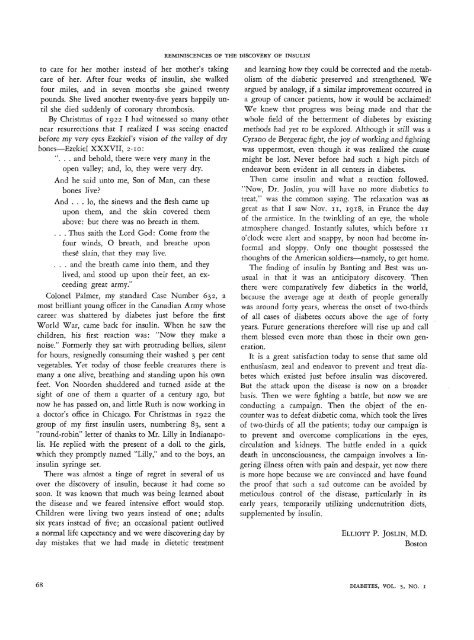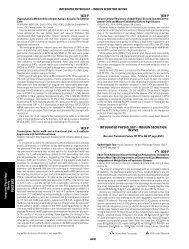Reminiscences of the Discovery of Insulin - Diabetes
Reminiscences of the Discovery of Insulin - Diabetes
Reminiscences of the Discovery of Insulin - Diabetes
Create successful ePaper yourself
Turn your PDF publications into a flip-book with our unique Google optimized e-Paper software.
to care for her mo<strong>the</strong>r instead <strong>of</strong> her mo<strong>the</strong>r's taking<br />
care <strong>of</strong> her. After four weeks <strong>of</strong> insulin, she walked<br />
four miles, and in seven months she gained twenty<br />
pounds. She lived ano<strong>the</strong>r twenty-five years happily until<br />
she died suddenly <strong>of</strong> coronary thrombosis.<br />
By Christmas <strong>of</strong> 1922 I had witnessed so many o<strong>the</strong>r<br />
near resurrections that I realized I was seeing enacted<br />
before my very eyes Ezekiel's vision <strong>of</strong> <strong>the</strong> valley <strong>of</strong> dry<br />
bones—Ezekiel XXXVII, 2-10:<br />
"... and behold, <strong>the</strong>re were very many in <strong>the</strong><br />
open valley; and, lo, <strong>the</strong>y were very dry.<br />
And he said unto me, Son <strong>of</strong> Man, can <strong>the</strong>se<br />
bones live?<br />
And . . . lo, <strong>the</strong> sinews and <strong>the</strong> flesh came up<br />
upon <strong>the</strong>m, and <strong>the</strong> skin covered <strong>the</strong>m<br />
above: but <strong>the</strong>re was no breath in <strong>the</strong>m.<br />
. . . Thus saith <strong>the</strong> Lord God: Come from <strong>the</strong><br />
four winds, O breath, and brea<strong>the</strong> upon<br />
<strong>the</strong>se slain, that <strong>the</strong>y may live.<br />
. . . and <strong>the</strong> breath came into <strong>the</strong>m, and <strong>the</strong>y<br />
lived, and stood up upon <strong>the</strong>ir feet, an exceeding<br />
great army."<br />
Colonel Palmer, my standard Case Number 632, a<br />
most brilliant young <strong>of</strong>ficer in <strong>the</strong> Canadian Army whose<br />
career was shattered by diabetes just before <strong>the</strong> first<br />
World War, came back for insulin. When he saw <strong>the</strong><br />
children, his first reaction was: "Now <strong>the</strong>y make a<br />
noise." Formerly <strong>the</strong>y sat with protruding bellies, silent<br />
for hours, resignedly consuming <strong>the</strong>ir washed 3 per cent<br />
vegetables. Yet today <strong>of</strong> those feeble creatures <strong>the</strong>re is<br />
many a one alive, breathing and standing upon his own<br />
feet. Von Noorden shuddered and turned aside at <strong>the</strong><br />
sight <strong>of</strong> one <strong>of</strong> <strong>the</strong>m a quarter <strong>of</strong> a century ago, but<br />
now he has passed on, and little Ruth is now working in<br />
a doctor's <strong>of</strong>fice in Chicago. For Christmas in 1922 <strong>the</strong><br />
group <strong>of</strong> my first insulin users, numbering 83, sent a<br />
"round-robin" letter <strong>of</strong> thanks to Mr. Lilly in Indianapolis.<br />
He replied with <strong>the</strong> present <strong>of</strong> a doll to <strong>the</strong> girls,<br />
which <strong>the</strong>y promptly named "Lilly," and to <strong>the</strong> boys, an<br />
insulin syringe set.<br />
There was almost a tinge <strong>of</strong> regret in several <strong>of</strong> us<br />
over <strong>the</strong> discovery <strong>of</strong> insulin, because it had come so<br />
soon. It was known that much was being learned about<br />
<strong>the</strong> disease and we feared intensive effort would stop.<br />
Children were living two years instead <strong>of</strong> one; adults<br />
six years instead <strong>of</strong> five; an occasional patient outlived<br />
a normal life expectancy and we were discovering day by<br />
day mistakes that we had made in dietetic treatment<br />
REMINISCENCES OF THE DISCOVERY OF INSULIN<br />
and learning how <strong>the</strong>y could be corrected and <strong>the</strong> metabolism<br />
<strong>of</strong> <strong>the</strong> diabetic preserved and streng<strong>the</strong>ned. We<br />
argued by analogy, if a similar improvement occurred in<br />
a group <strong>of</strong> cancer patients, how it would be acclaimed!<br />
We knew that progress was being made and that <strong>the</strong><br />
whole field <strong>of</strong> <strong>the</strong> betterment <strong>of</strong> diabetes by existing<br />
methods had yet to be explored. Although it still was a<br />
Cyrano de Bergerac fight, <strong>the</strong> joy <strong>of</strong> working and fighting<br />
was uppermost, even though it was realized <strong>the</strong> cause<br />
might be lost. Never before had such a high pitch <strong>of</strong><br />
endeavor been evident in all centers in diabetes.<br />
Then came insulin and what a reaction followed.<br />
"Now, Dr. Joslin, you will have no more diabetics to<br />
treat," was <strong>the</strong> common saying. The relaxation was as<br />
great as that I saw Nov. 11, 1918, in France <strong>the</strong> day<br />
<strong>of</strong> <strong>the</strong> armistice. In <strong>the</strong> twinkling <strong>of</strong> an eye, <strong>the</strong> whole<br />
atmosphere changed. Instantly salutes, which before 11<br />
o'clock were alert and snappy, by noon had become informal<br />
and sloppy. Only one thought possessed <strong>the</strong><br />
thoughts <strong>of</strong> <strong>the</strong> American soldiers—namely, to get home.<br />
The finding <strong>of</strong> insulin by Banting and Best was unusual<br />
in that it was an anticipatory discovery. Then<br />
<strong>the</strong>re were comparatively few diabetics in <strong>the</strong> world,<br />
because <strong>the</strong> average age at death <strong>of</strong> people generally<br />
was around forty years, whereas <strong>the</strong> onset <strong>of</strong> two-thirds<br />
<strong>of</strong> all cases <strong>of</strong> diabetes occurs above <strong>the</strong> age <strong>of</strong> forty<br />
years. Future generations <strong>the</strong>refore will rise up and call<br />
<strong>the</strong>m blessed even more than those in <strong>the</strong>ir own generation.<br />
It is a great satisfaction today to sense that same old<br />
enthusiasm, zeal and endeavor to prevent and treat diabetes<br />
which existed just before insulin was discovered.<br />
But <strong>the</strong> attack upon <strong>the</strong> disease is now on a broader<br />
basis. Then we were fighting a battle, but now we are<br />
conducting a campaign. Then <strong>the</strong> object <strong>of</strong> <strong>the</strong> encounter<br />
was to defeat diabetic coma, which took <strong>the</strong> lives<br />
<strong>of</strong> two-thirds <strong>of</strong> all <strong>the</strong> patients; today our campaign is<br />
to prevent and overcome complications in <strong>the</strong> eyes,<br />
circulation and kidneys. The battle ended in a quick<br />
death in unconsciousness, <strong>the</strong> campaign involves a lingering<br />
illness <strong>of</strong>ten with pain and despair, yet now <strong>the</strong>re<br />
is more hope because we are convinced and have found<br />
<strong>the</strong> pro<strong>of</strong> that such a sad outcome can be avoided by<br />
meticulous control <strong>of</strong> <strong>the</strong> disease, particularly in its<br />
early years, temporarily utilizing undernutrition diets,<br />
supplemented by insulin.<br />
ELLIOTT P. JOSLIN,<br />
M.D.<br />
Boston<br />
68 DIABETES, VOL. 5, NO. I
















